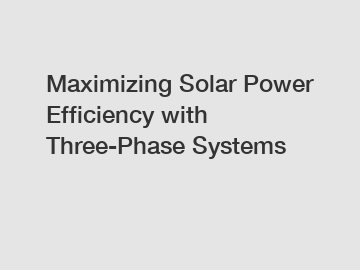Maximizing Solar Power Efficiency with Three-Phase Systems
Maximizing Solar Power Efficiency with Three-Phase Systems: Can it Revolutionize Renewable Energy?
Renewable energy sources have gained significant traction in recent years due to their ability to reduce carbon emissions and mitigate climate change. Among them, solar power has emerged as one of the most popular and promising options. However, as we strive to transition to a more sustainable future, it is crucial to explore ways to maximize solar power efficiency. One such promising approach is the utilization of three-phase systems. In this article, we will delve into the potential benefits and limitations of three-phase systems in maximizing solar power efficiency.
1. Enhanced Power Output:

One of the primary advantages of implementing three-phase systems in solar power generation is the potential for enhanced power output. Traditional single-phase systems may not efficiently handle the high current loads generated by solar panels. Conversely, three-phase systems allow for a more balanced distribution of power across multiple phases, resulting in better current handling capacity. This improved distribution enables solar installations to operate closer to their maximum power output, thereby maximizing energy generation and improving overall efficiency.
2. Better Grid Integration:
Efficiently integrating solar power into existing electrical grids remains a significant challenge. Three-phase systems offer a solution to this problem. As solar installations grow in scale, they require seamless integration with the grid to ensure a reliable and stable power supply. Three-phase systems provide better compatibility with grid infrastructure by allowing for easy synchronization with the grid's three-phase power supply. This integration facilitates smooth power flow and minimizes grid instability issues, ultimately maximizing the overall efficiency of solar power generation.
3. Reduced Transmission Losses:
Transmission losses during power distribution is a common concern in renewable energy systems. Traditional single-phase systems may exacerbate these losses due to their limited power capacity and inherent voltage drop issues. On the other hand, three-phase systems distribute power more evenly, reducing transmission losses and minimizing voltage drops. This improved energy transmission efficiency enables solar power to reach end-users with minimal wastage, making three-phase systems a viable option for maximizing solar power efficiency.
4. Overcoming Shadow Effects:
Shadows cast on solar panels, whether from nearby buildings, trees, or other obstacles, can significantly reduce the overall power output. Single-phase systems are particularly susceptible to such shadow effects as they rely on series-based or centralized inverters. In contrast, three-phase systems employ distributed inverters, allowing for better adaptation to localized shading conditions. By leveraging multiple inverters, three-phase systems can maintain the overall efficiency of the solar array, even in the presence of shadows. This capability is crucial in urban environments where shading is inevitable and can help maximize energy generation under varying conditions.
5. Limitations and Considerations:
While three-phase systems offer numerous advantages, there are a few limitations and considerations to keep in mind. Firstly, their initial setup and installation costs may be higher compared to single-phase systems. However, these costs can often be justified by the long-term benefits and increased efficiency. Additionally, the grid infrastructure needs to support three-phase systems to enable seamless integration. Retrofitting existing electrical grids can be a challenge in some regions, requiring significant investments. Furthermore, the implementation of three-phase systems may require specialized knowledge and expertise, necessitating training for technicians and professionals.
Conclusion:
Maximizing solar power efficiency is imperative to achieve sustainable and reliable renewable energy systems. Three-phase systems offer a promising solution by enhancing power output, improving grid integration, reducing transmission losses, and overcoming shadow effects. While they may present some initial challenges and require additional investments, the long-term benefits they provide make them a viable option for maximizing solar power efficiency. As we continue to advance renewable energy technologies, exploring new approaches like three-phase systems can revolutionize the way we harness solar power and propel us closer towards a greener and more sustainable future.
If you are looking for more details, kindly visit commercial inverters, three phase inverter, 1 phase hybrid inverter factory.

Comments